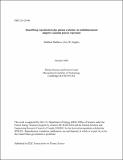| dc.contributor.author | Mathews, Abhilash | en_US |
| dc.contributor.author | Hughes, Jerry W. | en_US |
| dc.date.accessioned | 2025-03-21T20:11:37Z | |
| dc.date.available | 2025-03-21T20:11:37Z | |
| dc.date.issued | 2020-10 | |
| dc.identifier | 20ja090 | |
| dc.identifier.uri | https://hdl.handle.net/1721.1/158562 | |
| dc.description | Submitted for publication in IEEE Transactions on Plasma Science | |
| dc.description.abstract | The edge density and temperature of tokamak plasmas are strongly correlated with energy and particle confinement and their quantification is fundamental to understanding edge dynamics. These quantities exhibit behaviours ranging from sharp plasma gradients and fast transient phenomena (e.g. transitions between low and high confinement regimes) to nominal stationary phases. Analysis of experimental edge measurements therefore require robust fitting techniques to capture potentially stiff spatiotemporal evolution. Additionally, fusion plasma diagnostics inevitably involve measurement errors and data analysis requires a statistical framework to accurately quantify uncertainties. This paper outlines a generalized multidimensional adaptive Gaussian process routine capable of automatically handling noisy data and spatiotemporal correlations. We focus on the edge-pedestal region in order to underline advancements in quantifying time-dependent plasma profiles including transport barrier formation on the Alcator C-Mod tokamak. | |
| dc.publisher | IEEE | en_US |
| dc.relation.isversionof | doi.org/10.1109/tps.2021.3123046 | |
| dc.source | Plasma Science and Fusion Center | en_US |
| dc.title | Quantifying experimental edge plasma evolution via multidimensional adaptive Gaussian process regression | en_US |
| dc.type | Article | en_US |
| dc.contributor.department | Massachusetts Institute of Technology. Plasma Science and Fusion Center | |
| dc.relation.journal | IEEE Transactions on Plasma Science | |
